- Author Matthew Elmers [email protected].
- Public 2023-12-16 21:49.
- Last modified 2025-01-24 09:17.
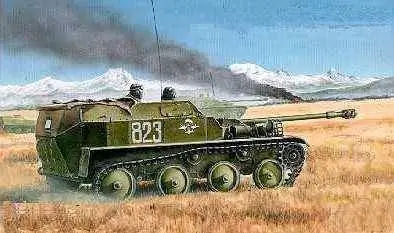
Airborne troops were first successfully used in World War II, for example: Operation Mercury (from 20 to 31 May 1941), when the 7th Parachute Division and 22nd Airmobile Division of the Wehrmacht captured Crete.
However, the Second World War showed that the airborne units needed to increase their firepower. So the losses of the Wehrmacht during the assault on Crete, amounted to about 4 thousand people killed and about 2 thousand wounded, most of them are paratroopers.
In the Soviet Union, there was an understanding of this problem. Even in the 30s, they tried to equip the landing troops with guns, mortars, light tanks, armored vehicles. They practiced dropping the T-27 tankettes by parachutes, splashed down the T-37.
But there were not enough opportunities and resources to achieve more, in the Great Patriotic Landing, in fact, in terms of armament, it did not differ from rifle units.
After the war, N. A. Astrov's design bureau was tasked with developing special equipment for the Airborne Forces. Already during the war years, it developed light tanks for the landing.
ASU-76
Already in 1949, the ASU-76 airborne self-propelled artillery unit was adopted for service. Its hull was welded from steel sheets up to 13 mm thick - this protected the crew from small arms and shrapnel. A 76 mm D-56T cannon was placed in the open-top wheelhouse, and an ammunition load of 30 rounds was also placed there. The OPT-2 sight was installed, with the help of it it was possible to fire both direct fire and from closed positions. An RP-46 light machine gun was installed on the left side of the fighting compartment.
A GAZ-51E carburetor engine with a 4-speed gearbox was installed on the right side of the aft part of the cabin.
The undercarriage consisted of leading front wheels, 4 support and 2 carrier rollers on board. The suspension was installed torsion bar, with hydraulic shock absorbers on the front nodes. The role of the guide roller was played by the last support roller, which provided the length of the support surface necessary to improve the cross-country ability. In order to increase the stability of the machine when firing, they put brakes in the road wheels, and the guide wheels were made self-braking.
There were tests of the floating model ASU-76. But in the end, the series was abandoned, the aviation could not transport them.
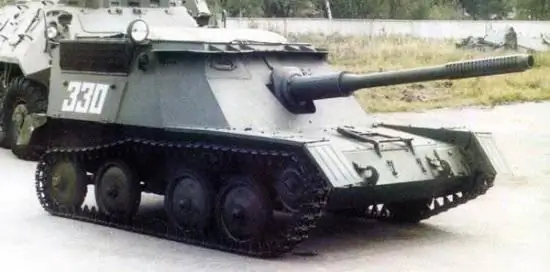
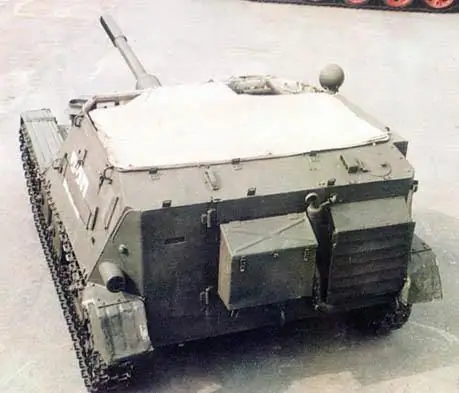
ASU-57
In 1951, the lighter ASU-57 was ready. The weight was reduced by reducing the armor to 6 mm and using aluminum alloys, they also reduced the size of the vehicle. A 57 mm Ch-51M cannon, designed by E. V. Barko, was installed, the projectile speed was 1158 m in the village, the ammunition load was 30 subcaliber shells. A small 4-cylinder M-20E engine was installed across the body, in a block with a 4-speed gearbox and side clutches. For a quick replacement of the power unit, it was held in place by 4 bolts.
Due to the decrease in the weight of the self-propelled gun, the specific pressure on the ground has decreased. The features of the chassis were retained from the ASU-76.
In 1954, the floating ASU-57P appeared. They installed a waterproof case, improved the Ch-51M cannon by equipping it with a more technologically advanced active muzzle brake. The engine was improved to 60 hp. with. The water propeller was installed with 2 propellers driven by guide wheels.
ASU-57P was not accepted into service, it was considered that ASU-57 was already enough in the troops, moreover, more advanced equipment was being developed.
Serially produced at the Mytishchi Machine-Building Plant from 1951 to 1962.
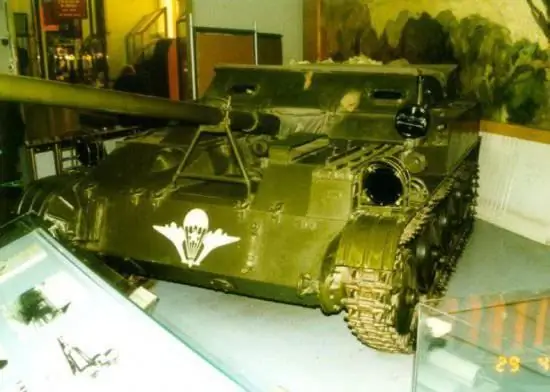
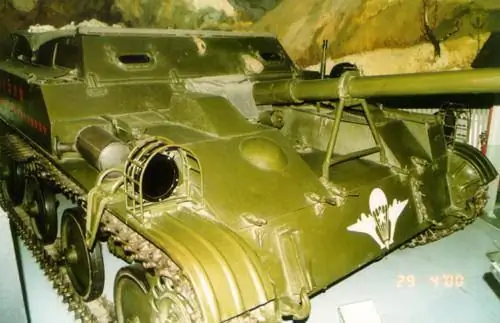
SU-85
In 1951, the design of a more powerful self-propelled gun than the SU-76 was started. The hull front plate was 45 mm thick and inclined at 45 degrees to protect the crew from armor-piercing shells of small and medium caliber. The wheelhouse housed an 85-mm D-70 cannon with an ejector, paired with an SGMT machine gun. The muzzle velocity of an armor-piercing projectile is 1005 m. made the SU-85 a serious weapon.
The self-propelled gun was equipped with a 6-cylinder 210-horsepower two-stroke automobile diesel YMZ-206V. To ensure the required power density, an ejection cooling system was introduced. The engine was placed across the body. The single-plate clutch proved to be unreliable and was later replaced with a multi-plate clutch.
The self-propelled gun was equipped with night vision devices, a radio station, and smoke bombs BDSH-5 were attached to the stern.
The SU-85 was modernized twice - a ventilated roof was created above the fighting compartment. In the 70s, they were armed with a DShK anti-aircraft machine gun.
Self-propelled guns entered both the ground and the airborne troops. Was in service with the airborne forces of the Soviet Union in the period from 1959 to the moment the BMD-1 entered service in the late 60s.
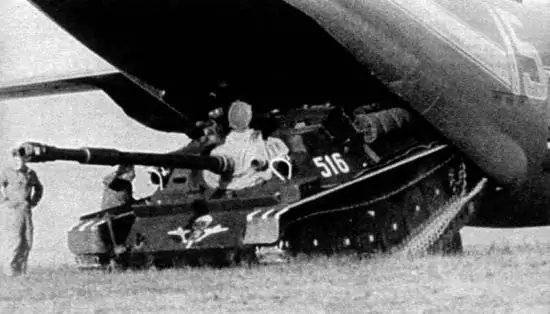
TTX ASU-57 (SU-85)
Weight, t - 3, 3 (15, 5)
Crew - 3 (4)
Length with gun, mm - 5750 (8435)
Body length, - mm 3480 (6240) Width, mm - 2086 (2970)
Height, mm - 1460 (2970)
Clearance, mm 300 (420)
Speed, km per hour - 45 (45)
Cruising in store, km - 250 (360)
Reservation, mm, forehead - 6 (45)
Board - 4 (13)
Poop - 4 (6)
Gun caliber, mm - 57 (85)
Ammunition - 30 (45)

ASU-85 on the streets of Prague. The invasion of Czechoslovakia in 1968 began with the landing of soldiers of the 103rd Guards Airborne Division at the Prague airport and the capture of it.






